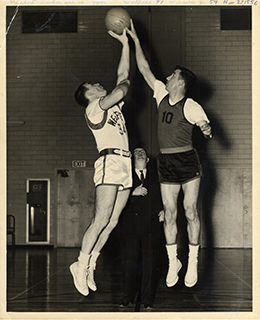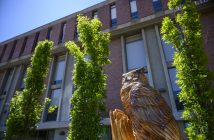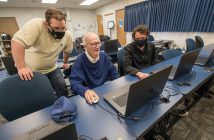175 years in Westfield State athletics.
Intercollegiate athletics have been a “front porch” of the University for the past 65 years, providing Westfield State with a steady flow of local, regional and national recognition. The Owls’ teams and student athletes have been honored for their successes on and off the playing fields, with highlights including three NCAA Final Four teams, four first-team All-Americans and 18 conference scholar athletes of the year.
Sports participation was also an integral part of the Westfield State experience during the years when it was a small school consisting of an all-female student body. During the 1916-17 academic year, for example, 38 weeks of physical training was part of the curriculum, including gymnastics, games and folk dancing.
The following is a brief timeline of the history of Westfield State athletics, with a special thanks to the tireless research efforts of Bob Farr ’55 and the late Don Farr ’57.
In 1926, Theresa Lammers—for whom Lammers Hall is named—began her 39 years at the College as a physical education instructor. Lammers was appointed head of the Biology department in 1943 and Erna Bayless replaced Lammers as the physical education instructor, a position she held until her retirement in 1968.
In addition to the curriculum requirements for physical education, Lammers and Bayless promoted participation as advisors of the Women’s Athletic Association (WAA), whose slogan was “a team for every girl and every girl on a team.”
Westfield State was a Normal School consisting of junior and senior women in the 1920s, and athletics competition was held between the two classes. Westfield State became a four-year school in 1934, and competitions were held between each of the four classes in the third floor gym at Dickinson Hall and the outdoor fields at the downtown campus.
Spearheaded by Lammers and the Student Athletic Council, the College adopted a new plan of athletic endeavor in October of 1937. The entire student body was divided into two teams, the Blues and the Whites. The purpose was to encourage competition between groups rather than between classes. Sports included basketball, softball, tennis, bowling and field hockey.
Men—14 in total—returned to Westfield State in 1938 after an absence of 25 years, and the Men’s Athletic Association (MAA) was founded with Professor Frederick Conlin serving as the advisor for 10 years.
The first documented intercollegiate games in school history were during the 1939-40 academic year, when Westfield played men’s basketball games versus North Adams and Hyannis College. Interestingly, the Hyannis game at Cape Cod was broadcast by two student radio announcers.
After a six-year hiatus because of World War II, intercollegiate athletics for men resumed during the 1947-48 academic year and the first basketball game of the post-war era was played on Dec. 6, 1947, at Keene State in New Hampshire. Professor Edward Welch began an eight-year stint as the Men’s Athletic Association advisor, and he coached Westfield State’s first intercollegiate baseball team in 1950.
The first documented intercollegiate competition for women was in 1950, when Westfield played a home-and-home basketball series with American International College. It would be nearly 20 years, however, before Westfield State’s women played another intercollegiate game, due to factors including cost and the lack of teams with equal standing.
A new era of athletics began in 1956, when the college moved from downtown Westfield to Western Avenue. The new campus included a state-of-art gymnasium, and the first intercollegiate game in Parenzo Gym was a 76-54 men’s basketball victory over Worcester State on Nov. 30.
Westfield State welcomed its first full-time athletics director and baseball/basketball coach—Charles “Bud” Hagan—in 1956, and Westfield State became a member of the popular 16-team New England State Teachers Conference. Hagan also served as a physical education instructor and offered many intramurals programs to the general student body, including volleyball, basketball, touch football and baseball.
Another significant year was 1963, when Paul Bogan began his 32-year stint as Westfield State’s athletics director. Bogan also coached – baseball 10 years, basketball four years – and oversaw the rapid expansion of the varsity athletics program, which grew from three varsity teams—baseball, basketball, soccer—in the 1960s to 19 teams a decade later, in part due to the College’s dramatic increase in enrollment and the passage of the landmark Title IX legislation in 1972.
Dr. Tilia Fantasia, who chaired Westfield State’s department of Physical Education for Women from 1968-1971, initiated the women’s varsity sports of field hockey, basketball, softball, gymnastics and volleyball shortly after arriving to Westfield State in 1966.
The College became a member of the National Collegiate Athletic Conference (NCAA) in 1965. The Massachusetts State Collegiate Athletic Conference (MASCAC) was formed in June of 1971; it is the nation’s oldest Division III men’s and women’s playing conference.
Three more varsity sports, including football in 1982, were added as Westfield State’s athletics program reached a peak of 22 teams. The Massachusetts budget crisis of the late 1980s, however, forced the suspension of seven sports in 1989 to maintain a competitive and representative Intercollegiate Athletics department. Kenneth Magarian ’71 served a 10-year stint as athletics director from 1996-2005. Magarian had been the Owls’ highly successful baseball coach in the late 1970s and directed Westfield State’s popular intramurals program for more than two decades.
Westfield State received a huge boost when its long-awaited athletics field house—the Woodward Center—opened in September of 2004. The Woodward Center also serves academics, housing the highly acclaimed Westfield State movement science/athletic training program.
Westfield State continues to flourish today under the guidance of athletics director Richard Lenfest. Significant upgrades have been made to Westfield State’s outdoor playing fields, additional coaches have achieved full-time status, and fund-raising efforts to enhance the teams have dramatically increased. Field turf and a new press box were installed at Alumni Field in 2006, and the Jerry Gravel track was dedicated in 2009.
Gravel, the most successful and longest-tenured coach (1969-1997) in Westfield State history, guided the Owls to two New England championships and 20 MASCAC track and field titles and coached 32 All-America honors. The baseball and softball fields moved from the campus green to their present locations in 1989, and new dugouts were constructed at both fields in 2012. The baseball field was renamed Bud and Jim Hagan Field in 2013.
Westfield now offers 21 varsity sports—11 women, nine men and co-ed cheering—continuing the NCAA Division III philosophy of offering a broad-based athletics program to its student body.




